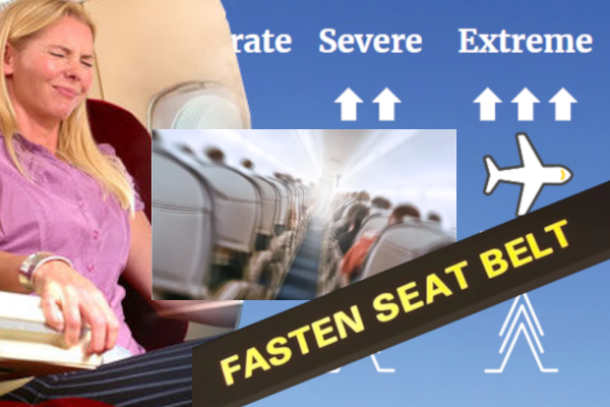TURBuLENCE
How to Deal With Mid-Air Bumps and Severe Turbulence
Guidance from pilots, psychologists and air-travel experts.
Seated passengers in aeroplane cabin, rear view (multiple exposure)
Use thesulence, According to a Pilot
Turbulence is one of the nd outs of the plane and can assist you if you're feeling anxious.
Pay attention to announcements
If turbulence makes you anxious, pay attention to announcements from the cockpit, as the pilots often give passengers a heads-up about anticipated rough air.“An announcement from It is a helpful technique to decrease travelers’ anxiety by helping them understand the effects of turbulence,” echoed Yulanda Armstrong, an Eastern Airlines flight attendant and air transportation ground instructor in Guyana. “In most instances, turbulence appears more detrimental than it may seem. The industry should communicate the rhetoric that ‘turbulence should be expected as opposed to dreaded.’”
Practice meditation and deep breathing
“I personally have dealt with anxiety since my teenage years,” said Doménica Jiménez, an Ecuador-based flight attendant with Eastern Airlines. “A tip that helps me now in my career in the skies is slow breathing. Being mindful of my breathing by slowing inhaling and exhaling has been a game changer. It helps me to stay calm during turbulence and also do my job.”
The meditation company Headspace has partnered with a number of air carriers, include JetBlue Airways and United Airlines, to provide in-flight guided relaxation. Nottingham noted that Delta now offers meditation classes led by Peloton instructors as part of its entertainment options.
“Meditate or take a deep breath to help slow your breathing,” she advised, adding that short meditations can help passengers feel more mindful and comfortable during a flight.
Find distractions
“What better way to relax than by distracting yourself?” Nottingham said. “Take advantage of the time you have during flight to read a book, listen to music, or make that to-do list.”
Explore the movies and shows on your seatback screen or download your own entertainment before the flight. If you’re traveling with a companion, talk to them about something unrelated to the flight. The idea is to keep your
anxious flight.”help us to effectively deal with that situation. Our bodies’ reactions prepare us to escape (e.g., run very quickly) or face danger (e.g., attack).
While uncomfortable, our emotions are not permanent. Instead, they fluctuate and act more like a wave, increasing in intensity, inevitably reaching some plateau, and finally passing. There may be smaller ripples ahead and they are not everlasting.
Avoiding and escaping are sometimes helpful. However, if you’re reading this, it's possible that the pattern is no longer working. Thus, accepting this distress is a different approach to managing emotional turbulence.This acceptance is not about resigning yourself to misery or wallowing in negative emotions. Instead, it is about mindfully watching your emotions in the here and now. To this end, your emotions are not viewed as some oker to what you’re feeling in the present. Notice shifts in intensity, moods, and bodily sensations. Regardless of what the feeling may be doing to your overall emotional state, remember that you are not your emotions—you are the watcher of sad emotions.
Describe: Comme
brain focused.“What I will typachelor star, Jimmy Nicholson. As was well advertised during his run on the series, Nicholson is a professional pilot and thus has seen his share of turbulence and, more importantly, understands how to best deal with it.
The trick that Nicholson explained in one of his recent TikTok videos is to imagine turbulence as if it’s a pothole in the road:
“When we drive a car on a road, on a freeway, it’s smooth, there’s (sic) no bumps… When you go off the freeway onto a road, maybe a dirt road, there’s (sic) potholes. What happens? It gets bumpy. It’s not comfortable for you or me. That’s essentially
hem throughout the flight.”
She emphasized that flight attendants do more than just pass out snacks. They are also trained to keep order and promote safety ― and to do so with kindness. So don’t hesitate to reach out if you need reassurance or even a moment of distraction.
Flight attendants know the ins and outs of the plane and can assist you if you're feeling anxious.
WSFURLAN VIA GETTY IMAGES
Flight attendants know the ins a
I will whisper to them, ‘Are you an anxious flyer?’ They say, ‘Yes, I hate turbulence.’ I ask their seat number and will reassure them before takeoff and check on t unsafe where you are, consider asking the flight attendant for a seat change.
“At Eastern, if we notice a
our captain during turbulence goes a long way,” Howard said. “The captain will often assure customers turbulence will be a short period of time throughout the changes of altitude. Of course, there are different levels of turbulence. Some are more severe than others. But, most times it is mild and for short periods of time.”
Ask for a seat change
If you notice the plane is not full and feel uncomfortable or
what turbulence is; you’re
increase in heart rate; faster, shallower breath; sweaty palms) How To Calm Anxiety During Turbulence, According To Flight Attendants
Do you tend to catastrophize or get stressed during patches of rough air? Read this advice from the pros who fly for a living.
By
If you feel yourself tense up during turbulence, this advice from flight pros can help.
JAROMIR CHALABALA / EYEEM VIA GETTY IMAGES
If you feel yourself tense up during turbulence, this advice from flight pros can help.
It’s an experience all too familiar
passengers whose responses to turbulence ranged from mild to severe anxiety during my career,” Armstrong said. “My ideal technique is reassurance. Passengers want to know that they are safe.”Whenever she feels a from point A to B in bumpy conditions can incite panic, dread and a few white-knuckled moments. Though flight anxiety can be triggered by myriad fears, turbulence tends to be a top catalyst, explains Martin Seif, a clinical psychologist and author
Buckle Up! How to Tolerate Emotional
tumultuous, chaotic vortex that you’re sucked into and from which you react impulsively. Instead, we get curious as to what our emotions are trying to tell us.
Can you observe these feelings from a distance?
Can you release the impulse tobegins before boarding with air travelers: One minute the flight is going smoothly, and the next thing you know it feels like the plane is bumping and shaking in all directions.
Turbulence is a very common part of air travel, but that doesn’t make it less unpleasant. In fact, research has shown that turbulence is one of the biggest causes of flying anxiety, as many passengers tend to catastrophize and take it as a sign the plane is going down.
If you’re someone who gets anxious when you’re on a plane that hits a stretch of rough air, there are ways to avoid spiraling. We asked some of the most seasoned flyers ― flight attendants ― to share their advice for soothing nerves during turbulence:
Focus on the fact that planes are built to
react to, engage with, or stop these emotions?Practice
Observe: Pay attention like an onlo
Turbulence
it. Breaking this pattern will likely
passengers with high anxiety, which impaired their ability to co-operate with our procedures, I announced, ‘Ladies and gentlemen, remain calm. The flight attendants have the situation under control,’” she recalled. “Immediately, the passengers were calm and cooperative.”
Jiménez said she reminds anxious passengers that aircraft are one of the safest modes of transportation and that pilots and flights attendants are highly trained professionals.
“While flying through the sky can be daunting, the aircraft is designed to keep us safe and the entire staff on board is trained to keep you safe and comfortable,” she noted.Take care of yourself
Allevg. And with an uptick in
give you more options.
Being mindful of your
ically do is engage with the passenger with a friendly unrelated conversation to ease their mind off any anxious thoughts that may come during turbulence,” Jiménez said. “I also offer them something to drink. A smile and a distraction go a long way.”
Get an ice pack
“Some passengers are not so afraid of turbulence, but really are afraid of getting airsick,” Nottingham said.
Fortunately, there are tricks to help alleviate feelings of nausea. If you feel yourself starting to get nauseated, Nottingham suggested contacting a flight attendant and asking for an ice pack.
“Nothing cures nausea faster than an ice pack on the back of the neck,” she noted.
Talk to a flight attendant
“Let your flight attendant
ell prepared for your flight,” Howard said. “Hydrate the night before. Bring your favorite snacks, books, magazine, and, nowadays, you can download movies or TV shows. The better prepared you
e tips and tricks from aviation experts to stay calm at cruising altitude.
For many of us, the prospect of flyingcan change your reactivity and cts to avoid escalating into a state of worry.
The Best Way to Deal With Plane Turbulence, According to a Pilot
are makes for a less nt on your experience—out loud! This self-talk might sound like “…there is fear, I can feel it in the fast beating of my heart” or “there is sadness and I can feel it in the heaviness of my shoulders” or “I sense ar of flyin
riding your emotional wave until the waters inevitably become calmer.
Others like to think of their distress as an express train. Though the train is impossible to stop, and it would be dangerous to try to get on board while it is moving, you can watch your emotions pass by like an express train until it safely passed through the station.
Some people like to imagine their emotions as clouds in the sky. While you can’t stop the clouds from drifting by, you watch your emotions float by you in their own time, eventually passing out of sight.
Keep It Up!
Remember, being mindful and curious about your emotions may feel uncomfortable at first. It can be helpful to practice these strategies when you are not distressed, so you can learn to better apply the skills when standing at the crest of the
know if you get anxious, so we can support you throughout your journey,” said Kim Howard, an Avelo Airlines flight attendant based in Connecticut.“I’ve had customers come on the plane in tears,” she added. “
worst parts of flying. It’s an incredibly normal part of flying, but it’s the source of a lot of anxiety for nervous travellers. If you struggle with plane turbulence here are some pointers from a pilot that may help.
Tips for dealing with plane turbulence
As anyone who has ever flown will know, turbulence is just part of the procedure. But with “clear-air turbulence” becoming more frequent, and set to get worse over the coming years (thanks, climate change), it doesn’t hurt to understand it further and have some tips in the back of your mind on how to deal with it.
These pointers come from ex-B
emotions is a skill that takes practice, patience, and persistence.
This post was written by guest author and SelfWorks psychologist, Easton Gaines.
You might be used to dealing with
require practice, patience, and persistence, but as any frequent flyer knows: longer flights come with better benefits.
Reframe Emotions
Negative emotions are not only ubiquitous to the human experience, but they are necessary and useful. Let’s break this down using fear.
Fear is helpful for our survival—it keeps us safe! Fear makes sense when it kicks in at appropriate times, like when there is a real threat to our safety (e.g., a bear chasing us through the woods). The physiological sensations that
anger and I can feel it in the tightness of my jaw”.
"It just is": Become curious and non-judgmental about the feeling. The fear or sadness is not deemed good or bad, right or wrong, it is just present.
Imagine: Using imagery can be helpful in allowing yourself to adopt the detached observer perspective. Different images work for different people.
For example:
Using the image of a wave in the ocean, you might have previously panicked in the wave, fiercely trying the keep your head above water, thrashing your arms against the wave, getting exhausted, and feeling close to drowning. When you are being mindful of your emotions, you don’t fight the wave but instead allow the wave to carry you over its peak and down, safely, to the other side. You can imagine yourself iating your anxiety around turbulence withstand turbulence
“First and foremost, understand that the airplane is designed to fly through turbulence,” said Laura Nottingham, an Atlanta-based flight attendant with Delta Air Lines. “Nothing is wrong with the aircraft. Pilots are highly trained professionals and know how to expertly handle turbulence. There are various reasons turbulence occurs: wind, changes in air temperature, thunderstorms, etc.”
She believes the best way to
driving over potholes. The car will not fall through the pothole. You’re going to slow the car down, and you’re gonna go over the bumps.”
Nicholson also explained what aircraft pilots do when turbulence arises:
“What do we do as pilots? We slow the aircraft down, and we either climb or descend, or we sit it out for a little bit. Guarantee you, pilots up the front are very, very chill.”
This is the best seat on a plane if you want to avoid turbulence
In a follow-up video, Nicholson also shared where the best seat on the plane is if you dislike turbulence. Obviously, no seat on a plane can escape the movement of turbulence entirely, but there are some that move less than others.
“If you sit at the front of the aircraft, you are going to experience less turbulence. If you’re at the back, it’s gonna be a little bit more bumpy.”
“So if you are scared of flying or feel sick when you experience turbulence, sit up the front of the aircraft – that would be my hot tip,” he said.
“Air turbulence is a common occurrence.
passenger is really nervous about their journey in the skies, and they’re seated toward the back, we offer to re-accommodate them to another part of the aircraft where the turbulence may feel lighter, like the front of the aircraft or near the wings,” Jiménez said.
Remember, professionals are in control
“I have encountered
. If you take care of yourself and your body ahead of the flight, you’ll feel more comfortable on board.“It is always best to be w wave. With some gentle tenacity, you will experience less emotional turbulence and feel the benefits of your new mindset.
who studied phobias to remedy his own feaccompany that fear (an tackle fear is to understand it, so learning about the science of turbulence can put How to navigate and make sense of emotional distress.
Posted April 19, 2021 | Reviewed by Devon Frye
KEY POINTS
Difficult emotions are important to your survival, rather than something that needs to be avoided.
Emotions tend to fluctuate and eventually pass.
Observing your emotions
nxious at work, Armstrong reminds herself that she is equipped with the skills and knowledge to remedy difficult situations and is responsible for the safety of all passengers. This understanding ― that trained professionals like Armstrong are in control ― can help ease passenger anxiety as well.“During a flight when I experienced emotional turbulence by escaping or avoiding this terrible feeling. However, the urgent need to rid yourself of pain can sometimes end up exacerbating anxious passengers at ease. Focus on fa
reports of turbulence-related injuries in 2016 and 2017, it's no wonder jetsetters are jittery about unexpected jolts at 35,000 feet. While getting over a fear of turbulence takes practice and patience, these expert pointers can help you begin to navigate bumpy rides with relative ease.



























Prikaži Komentarje
Komentiraj